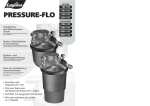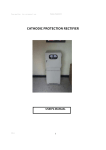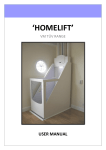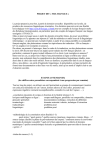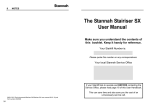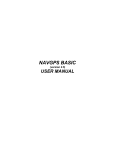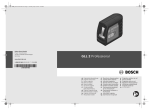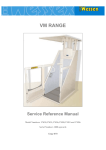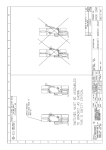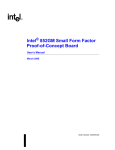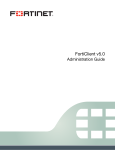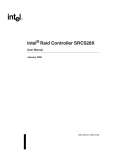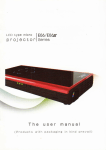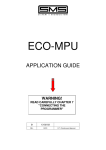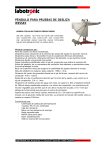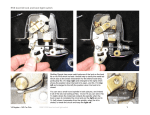Download Wessex Vertical Lift User Manual
Transcript
VERTICAL LIFT User Instruction CONTENTS INTRODUCTION VERTICAL LIFT - Illustration Page No. 3 4 FEATURES - Standard 5&6 FEATURES - Optional 7&8 SAFETY PRECAUTIONS 9 OPERATING INSTRUCTIONS Calling the lift to the required floor Opening the door Entering the car - seated model Use of the sliding seat (if fitted) Entering the car - wheelchair model Closing the door To travel to the required floor Changing direction of travel Vacating the lift Alarm Light 10 10 10 10 11 11 12 12 12 13 13 PROBLEMS OPERATING LIFT Hydraulic pressure failure Emergency lowering by lift car controls Emergency lowering by pump unit controls Emergency lowering button 14 14 14 14 DOOR FAILING TO OPEN 15 SERVICE AND INSPECTION 16 SPECIFICATION 17 ROUTINE CARE AND MAINTENANCE 18 EMERGENCY BREAKDOWN SERVICE 19 CHANGE OF USE 20 SERVICE AND INSPECTION RECORD 21 APPENDIX A - Periodic Examination Certificate Page 2 22-26 INTRODUCTION Thank you for buying the Wessex Vertical Lift. The Wessex range of lifts is the widest available on the market and combines the latest technology and design making them easy to use and aesthetically pleasing in the home, whilst offering long service and reliability. Wessex has extensive experience in providing products that aid mobility and is the pioneer of the majority of today’s domestic lifts. With this background and many years’ experience in the manufacture and installation of Vertical Lifts, Wessex is clearly the most experienced company in the market place. Our in-depth knowledge of associated building and electrical work and management expertise ensures that installations are completed with the minimum of inconvenience. The instruction manual will help you become accustomed to your lift. • Study and become familiar with the step by step instructions. • Ensure that a nominated person is also familiar with the instructions, especially the operating procedures in the event of a breakdown. • Keep the manual in a safe place for future reference together with the electrical wiring diagram. A pocket is provided inside the lift for the purpose. • The door release key should always be kept clipped in its place inside the lift car. IMPORTANT NOTICE - for Safe Use In preparing the British Standard for Domestic Powered Lifts Wessex Medical believe that BSI did not envisage the presence of unsupervised infants being left in the bedroom in which the lift is installed. Certainly in such cases, we do not believe it would be appropriate to allow an elevated car to be summoned from a remote call station. Children should not be allowed to tamper or play with the lift or tracks. Joyriding is dangerous. For extra safety switch off the keyswitch (optional extra) on the wall mounted control stations, and remove key. The area above and below the travel of the car must be kept clear at all times. During travel do not impede the car or aperture board. Ensure that all persons, especially children and pets, are kept clear of the lift prior and during travel. Obstacles must not be placed on the aperture board or beneath the car. Keep hands, etc. inside the lift at all times. Do not lean out of lift. PRE PAYMENT METERS British Standards (BS 5900) catergorically states that Powered Domestic Lifts shall not be used in conjunction with a pre payment meter. Wessex Medical support the principles laid out in the standard and recommends that lifts should not be installed with a pre payment meter insitu and that there should not be any change from a dedicated supply. Page 3 VERTICAL LIFT ILLUSTRATION Page 4 FEATURES - Standard • ALARM An audible alarm system is fitted and operated by a push button switch on the car console. Also the switch can be supplied as an option to operate a remote mounted alarm either on the premises or linked to an external telephone system. • ALL ROUND VISION High quality, fire resistant transparent panels are fitted allowing a clear view of surroundings. • APERTURE BOARD If, during raising or lowering the lift, the aperture board is impeded in any way, the lift will immediately STOP. This is achieved through in built safety switches. SENSITIVE SURFACE • BATTERY BACKUP FEATURES In event of an electricity supply failure, the following items within the lift will continue to function through a battery backup system: 1. 2. 3. 4. 5. 6. 7. • HARD WEARING FLOOR COVERING • CAR SENSITIVE EDGES/ SURFACES • DOOR Emergency Lowering Button Relevant safety switches Powered door Stop Alarm Manual door lock Integral lighting (one light only) The interior floor area of the lift is fitted with a hard wearing and easily cleaned floor covering. If either the upper or lower sensitive edges of the car are impeded in the direction of travel the lift will immediately STOP. Again this is through in built safety switches. The lift will operate only if the door is properly closed and locked. The door of the lift cannot be opened BETWEEN floors (unless in an emergency - see ‘In the event of the door failing to open’). Page 5 FEATURES - Standard / Cont. • DOOR CLOSING STRAP Fitted as standard on wheelchair models without powered doors. • ELECTRICITY TO CONTROL A safe low voltage supply is used for all car controls. • EMERGENCY LOWERING BY LIFT USER An emergency lowering button is provided within the lift should the lift stop due to a power cut or mains failure. The in-car emergency lowering button will illuminate and the pump motor will cut out. • EMERGENCY LOWERING AT PUMP CONTROL In the event of an emergency, means are provided to permit the lift to be lowered. - See ‘Problems Operating Lift’. • FIRE AND DRAUGHT SEAL In accordance with BS5900, all models incorporate a fire seal, which is effective when the car is parked at the first floor level. Wessex therefore recommends that the car be parked at the first floor when not in use. • GRAB HANDLES Front or side mounting positions available. Front handles fitted as standard on seated version. • HYDRAULIC PRESSURE FAILURE In the unlikely event of an oil pressure pipe failure, a safety valve will immediately stop the lift.Refer to ‘Safety Precautions’. • ILLUMINATED CAR CONTROLS For ease of identification all in car push buttons are illuminated. These buttons control all operations of the lift. • LIGHTING Internal illumination of the car, with battery backup is provided by two low voltage switched lights at the back of the car. Lights automatically switch off when lift is not in use. • TELEPHONE CONNECTION Connection sockets for the fitting of a telephone are provided as standard. • WALL MOUNTED CONTROL STATIONS AT GROUND & FIRST FLOOR LEVELS Used to call the lift, or send it to its ‘parked’ position away from current floor (if appropriate), and to operate the powered door if fitted. Page 6 FEATURES - Optional • SEAT VARIATIONS For ease of access and personal preference, a choice of 3 types of seating is available - bench, perch (both these can be tipped up if/when not required) and sliding (seated model only). • TELEPHONE HANDSET This option is strongly recommended. Others must fit telephone supply socket to the household for connection to the lift. • POWERED DOOR A push button switch on the lift console operates a powered door. For safety, the door will immediately STOP if obstructed and the lift will not operate. (Available for wheelchair models only). LOCKING KEY SWITCHES A 2-way personal key switching facility can be provided. Option 1 - 2-way key switched on both upper and lower wall mounted call stations. Option 2 - Lift-car mounted key switch to render incar push button console inoperative. Page 7 FEATURES - Optional / cont. • GRAB HANDLES In wheelchair models grab handles can also be offered as an option to assist mobility. • LAP STRAP A lap strap with an adjustable quick release buckle can be offered to suit the range of seats. • DOOR CLOSING STRAP A braided, rope strap can be fitted inside the door to assist closing. (Fitted as standard on manual door models). • AUTO HOMING To ensure the lift always returns to the first floor level, the car will automatically rise to the first floor after a preset time from the door closing. • AUTO DOOR CLOSING To ensure the lift door always closes after a preset (Powered Door Only) time after arrival at a landing level. • RADIO CONTROL Remote operation of user lift functions. Page 8 SAFETY PRECAUTIONS • OVERLOAD Do not exceed the safe lifting capacity of the unit, which is 225 kg (35 Stone). • SINGLE USER It is strongly recommended that this lift be for a single person either sitting down or in a wheelchair. • OBSTRUCTIONS The area above and below the travel of the car must be kept clear at all times. During travel do not impede the car or aperture board. Ensure that all persons, especially children and pets, are kept clear of the lift prior and during travel. Obstacles must not be placed on the aperture board or beneath the car. Keep hands, etc. inside the lift at all times. Do not lean out of lift. • SEAT BELT Where fitted, adjust length of buckle and always fit prior to use of the lift. • DOOR OPENING Do not attempt to force the door open during travel or attempt to operate the lift with the door held closed. The door should always be closed when not in use. • CHILDREN Children should not be allowed to tamper or play with the lift or tracks. Joyriding is dangerous. For extra safety switch off the keyswitch (optional extra) on the wall mounted control stations, and remove key. • FIRE SEAL To form the mid floor fire seal it is essential that the lift is parked at the first floor when not in use. • DOOR RELEASE KEY The key should be available in car at all times. • LIFT MAINTENANCE The manufacturer recommends that the lift is serviced/checked every 6 months. Note: Most hydraulic drive systems used for this type of product ‘settle’ when not in use over a long period of time. With the car at ground level there is little effect, but at the first floor level the car may drop by as much as 25mm (1 inch) before the self leveling system is activated. This is perfectly normal and quite safe. This relevelling can occur even with the lift door open and so may happen as you are entering / exiting the lift. Page 9 OPERATING INSTRUCTIONS • CALLING THE LIFT Insert and turn personal security key (If this option is fitted) on wall control station at either ground or first floor. Press and release the appropriate push button. The lift will automatically stop at entry level required. Wall Control Station • OPENING THE DOOR – to enter the car For manual opening of the door, depress the safety edge as shown, and gently pull. For powered door opening (optional extra) press the door-opening button on the wall mounted call station. All lights in the car will automatically illuminate. Opening The Door A powered door (if fitted) can be opened manually, if this is done the door must be closed manually. Note: Do not lean on the door safety edge without opening the door otherwise the lift will not operate. However the lift can be reset by opening / closing the door • ENTERING THE CAR - Seated model. Enter the car; use seat provided and fit seat belt (see options). Seated Model Page 10 Use of sliding seat (Optional feature). Raise the seat release lever located under the front of the seat and pull forward until the release lever re-locks into position. Transfer from the wheelchair onto the lift seat and whilst seated, raise the release lever and slide the seat to the back of the car until the release relocks. OPERATING INSTRUCTIONS • ENTERING THE CAR - Wheelchair model. It is recommended that you reverse the wheelchair into the car wherever possible. • CLOSING THE DOOR - manual door option Pull the braided rope gently provided on manual doors to close the door (see door closing strap option page 8). After opening there is a 5-second delay of the automatic lock reset mechanism before the door can be closed. The door must be fully closed and locked before operating lift. • CLOSING THE DOOR – powered door option Press the door-operating switch. The door will close and lock. Entering The Lift Closing The Door Lift Car Controls It is not recommended that the powered door is opened manually (only in emergency situations) However, If the powered door is opened manually it must be closed manually to re-engage the door mechanism Page 11 OPERATING INSTRUCTIONS • TO TRAVEL TO THE REQUIRED FLOOR The door must be fully closed and locked before operating the lift. The stop button must be illuminated before the lift will operate. There may be a small time delay after Press and release the appropriate push button or The stop button travel. • CHANGING DIRECTION OF TRAVEL to travel. can be used at anypoint during If you wish to return to the floor you have departed from, mid journey, stop the lift by pressing the stop button. After a 3 second delay, the up, down and stop lights will illuminate. Press and release the appropriate push button with the direction of travel required marked on it, and the lift will return to that floor. Alternatively, the original direction can be maintained. • VACATING THE LIFT Page 12 Move forwards and exit the lift after opening the door. Close the door either manually or if using the powered door option, use the door close switch on the wall mounted call station. When not in use the lift should be parked at first floor to ensure the fire seal between floors. OPERATING INSTRUCTIONS • ALARM In the event of emergency assistance required, press and hold in the alarm button. • LIGHT The 2 interior lift lights will illuminate: - by pushing the light in the lift car. ‘push button’ - or when the ‘door open switch’ is used. - After calling the lift and after a period of 4 minutes, the light will automatically go out. They will illuminate when the door is operated. • AFTER USE If fitted turn the personal key switch (on either wall control station) to immobilise the lift. The key can now be removed to prevent unauthorised use. Ensure the door is closed. Page 13 PROBLEMS OPERATING LIFT In the event of a power failure whilst using the lift the following may be considered. However, we strongly recommend that should a power failure occur when not in use the lift should not be accessed or emergency lowered. • • HYDRAULIC PRESSURE AND • • EMERGENCY LOWERING • • EMERGENCY LOWERING BY PUMP UNIT CONTROL ELECTRICAL POWER FAILURE CONTROLS IN LIFT CAR In the event of a power failure, the self-leveling device will not function. A ‘Shoot Bolt’ safety device restricts the distance the lift can creep down from the first floor position. This position is such that evacuation of the lift is possible at the first floor level only by using the emergency k e y to open the door (see page 15). The lift can only be re-used when power returns. First check the lift route and the ground floor are clear of any obstructions. Next press the illuminated emergency- lowering button on the console. The lift will gently lower to the ground floor where the user can vacate the car. The emergency lowering facility can also operate directly from the hydraulic pump unit. First switch off the electrical supply at the switch adjacent to the lift. Open the hydraulic pump unit enclosure with the key provided. Push or pull and hold the valve button as shown. The lift will gently lower to ground level. This feature will not work if the lift is at the upper floor level in which case the user can exit the lift upstairs by opening the door IMPORTANT SAFETY NOTE Remove any obstructions and keep other persons well clear before lowering as this emergency method bypasses existing lift safety systems. Page 14 IN THE EVENT OF THE DOOR FAILING TO OPEN Both manual and powered doors can be opened from the inside or outside of the car - by using the door release key normally clipped on the inside of the lift car. For safety reasons it is recommended that the door release key should normally be used from outside of the car, by a third party assistant. It should never be used from inside the lift car if it is not parked at the landing level. • To open the door, follow this procedure: • Ensure the lift is either positioned at the ground floor or the upper floor landing level. • Place the key in the lock access hole in the door panel and gently push (1) and lift up (2) as diagram. • Gently pull or push the door open whilst holding the key. SAFETY NOTE In the interests of safety, please ensure that the DOOR RELEASE KEY is never left in the lock access hole. To guard against this, the key is fitted with an integral spring. NOTE: We strongly recommend that you keep the key in a convenient place in case of emergency - in the fixtures provided within the lift Page 15 SERVICE AND INSPECTION Your Vertical Lift has been inspected and tested to ensure safety and reliability. It should give you many years of service as long as regular maintenance is correctly carried out. Failure to do this could lead to unreliable or unsafe operation. The lift is guaranteed for 12 months, unless you have decided to purchase an extended warranty at the same time as buying your unit. Alternatively, you may wish to establish a maintenance agreement that will provide for routine servicing on a regular basis thereafter. Wessex recommends that the lift is checked/serviced every six months. The lift must be serviced to the BS 5900 schedule, which includes checks on the following: • • • • • • • Suspension member checks Safety interlock checks Electrical integrity checks Hydraulic pressure and safety valve checks Hydraulic leakage checks - (e.g. hoses, fittings etc.) Lubrication Screws and nuts(as applicable) A certificate similar to that shown in Appendix A should be prepared and recorded in a log to be retained on site. The examining authority should retain a copy. For all enquires regarding service please contact the Customer Service Department at: WESSEX MEDICAL EQUIPMENT COMPANY LIMITED, BUDDS LANE, ROMSEY, HAMPSHIRE SO51 0HA TEL: 01794 830303 FAX: 01794 512621 Email: [email protected] Website: www.wessexmedical.co.uk Page 16 SPECIFICATION All lifts comply fully with requirements of British Standard 5900:1999 ‘Specification for Powered Domestic Lifts’ and CE marked in accordance with ‘The supply of Machinery (safety) Regulations 1992. (for further information contact Wessex Medical Equipment Company Limited). STANDARDS MODELS DRIVE LIFT CAPACITY 1 PERSON INCLUDING WHEELCHAIR POWER SUPPLY CONTROL VOLTAGE FINISH POWER CONSUMPTION BS 5900 (1999) specification for powered domestic lifts Rear hung seated or wheelchair Hydraulic (direct acting ram) 225 Kg (35 Stone) The supply shall be dedicated solely to the lift and shall originate at the household consumer unit, terminating at a double pole control switch rated at 20 amps to BS3676. Pre-payment meters are not allowed 24 Volts D.C. Creamy White BS4800 - 10-B-15 toughened glass vision panels front and side 1000 Watts normal NOTE: THE COMPANY RESERVES THE RIGHT TO ALTER THE SPECIFICATION WITHOUT PRIOR NOTIFICATION TO MEET CONTINUED PRODUCT DEVELOPMENT REQUIREMENTS. Page 17 ROUTINE CARE AND MAINTENANCE CAUTION • Before cleaning the Vertical Lift tracks and call station, please remember to switch off the mains supply adjacent to the unit. • A variety of materials are used on the Vertical Lift and all lend themselves to ease of cleaning with a damp not wet, non-abrasive cloth and a mild detergent such as washing up liquid. Avoid getting the aperture ‘in fill’ board wet since this may change the characteristics of the board and affect it’s performance. This part must be considered when carrying out maintenance checks A weakened trap board must be replaced. • A furniture polish and duster are recommended for the transparent panels but DO NOT USE ABRASIVE CLEANERS. • Important Safety Notice • Do NOT under any circumstances paint the lift tracks as this could seriously impede the • • render the warranty void. sliding mechanism and therefore the running of the lift. Additionally, such action will Page 18 EMERGENCY BREAKDOWN SERVICE NOTE: The following procedure is for units installed by Wessex Medical only. For units installed by others please contact your local supplier. Wessex Customer Service Department is manned between the hours of 8.30am to 5.15pm, Monday to Friday (except public holidays) and field service engineers normally operate during the same hours. An engineer will normally visit within 24 hours (Monday to Friday) to attend to a breakdown call provided the equipment is covered by a warranty or the user (or any agency responsible for a maintenance of the equipment) agrees that they will cover any costs incurred. Calls for assistance outside normal office hours will be handled by our emergency cover service and every effort will be made to attend such calls within a reasonable time scale (i.e. within 24 hours) - however there is no guarantee that an engineer can be made available during these hours. During normal office hour’s telephone the number indicated below and ask for Customer Services. A member of staff will record details of your request and initiate the necessary actions to resolve the problem. Outside normal working hours telephone the number indicated below. This will provide you with our emergency service number, which you must ring. The operator will take details, and pass this information to the duty supervisor who will then contact you by telephone to fully assess the problem, and to offer a suitable level of technical assistance to minimise the immediate difficulties being experienced. Where necessary and feasible, the duty supervisor will make suitable arrangements for an engineer to attend site as soon as possible to effect repairs. In the event of a real emergency (e.g. lift stopping during travel with user on the lift platform), and if it is not possible, for whatever reason, to manually override the lift, our normal advice is to contact the emergency services (fire brigade) to obtain immediate assistance. For further information on breakdown cover and servicing please contact our Customer Services Department. EMERGENCY BREAKDOWN SERVICE 01794 830303 Page 19 CHANGE OF USE Any change of use of the lift should be discussed with Wessex who will be able to advise whether any alterations may be necessary. Examples of such changes are:- • A change of type and weight of wheelchair • A change in the user’s disability • A change in user • An installation at another site • A change of duty cycle (number of journeys per hour) WESSEX MEDICAL EQIPMENT COMPANY, BUDDS LANE, ROMSEY, HAMPSHIRE, ENGLAND, SO51 0HA TEL: 01794 830303 Part code: VM00 7100 Page 20 FAX: 01794 512621 Issue: F Date: June 2004 SERVICE AND INSPECTION RECORD SERVICE PERIOD ENGINEER’S NAME COMPANY SIGNATURE / DATE 6 MONTHS ONE YEAR 18 MONTHS TWO YEARS 30 MONTHS THREE YEARS 42 MONTHS FOUR YEARS 54 MONTHS FIVE YEARS 66 MONTHS SIX YEARS 78 MONTHS SEVEN YEARS 90 MONTHS EIGHT YEARS 102 MONTHS NINE YEARS 114 MONTHS TEN YEARS Page 21 APPENDIX A VERTICAL LIFT PERIODIC EXAMINATION CERTIFICATE NOTE: Statements and replies to the relavant question should be annotated in the appropriate boxes. Where ‘yes’ or ‘no’ replies are necessary the appropriate box only should be ticked. 1 Premises (a) Occupier (or owner) of Premises: (b) Address of premises: 2 Lift Data (a) Type of lift: (b) Lift serial no: (c) Description of Lift: (d) Date of construction or reconstruction (if ascertainable): 3 Construction of lift Are all parts of the lift of good mechanical construction, Yes No sound material and adequate strength (so far as is ascertainable): NOTE: Details of any renewals or alterations should be given in 6 and 7 below. Page 22 APPENDIX A 4 Condition of lift Are the following parts of the lift properly maintained and in good working order? If no, state what defects have been found. 1) 1) 1) 1) (a) Car doors Yes No (b) Interlocks on car doors: Yes No (c) Other door fastenings: Yes No (d) Car and fittings, car and counterweight guides: Yes No (e) Over running devices: Yes No (f) Suspension ropes and their attachments: Yes No If applicable Page 23 APPENDIX A 1) 1) 1) (g) Safety gear and overspeed governor (i.e. arrangements for preventing fall of the car and the counterweight): Yes No (h) Hydraulic valves: Yes No (i) Safety circuits, fuses and other electrical equipment: Yes No (j) Other part e.g. hydraulic fluid level: Yes No 5 Accessibility What parts (if any) were ‘inaccessible? 1) If applicable. Page 24 APPENDIX A 6 Repairs, renewals or alterations What repairs, renewals or alterations are required to enable the lift to continue to be used with safety? (a) Immediately: (b) Within a specified time limit: Specified time limit: NOTE: If no such repairs, renewals or alterations are required enter ‘none’. 7 Defects What defects (other than those in 6) require attention? 8 Safe working load Subject to the repairs, renewals or alterations (if any) stated in 6, what is the maximum safe working load of the lift? kg 9 Other observations Page 25 APPENDIX A 10 Declaration I/We certify that on I/We thoroughly examined this lift and that the foregoing is a correct report of the result. Signature(s): Position: Service Engineer Address(es): Budds Lane Romsey Hampshire SO51 0HA Date: Page 26 Service Engineer Part code: VM00 7100 Issue :E Date: January 2002 Wessex Medical Equipment Company Limited Budds Lane, Romsey, Hampshire, England SO51 0HA Tel: +44 (0)1794 830303 Fax: +44 (0)1794 512621 E-mail: [email protected] Website: www.wessexmedical.co.uk ISO 9001 FM 58435 CE Marked in compliance with European Regulations A Member of the Ratcliff Group The Wessex Policy is one of continuous product development and the Company therefore reserves the right to alter product or component specifications without notice






























